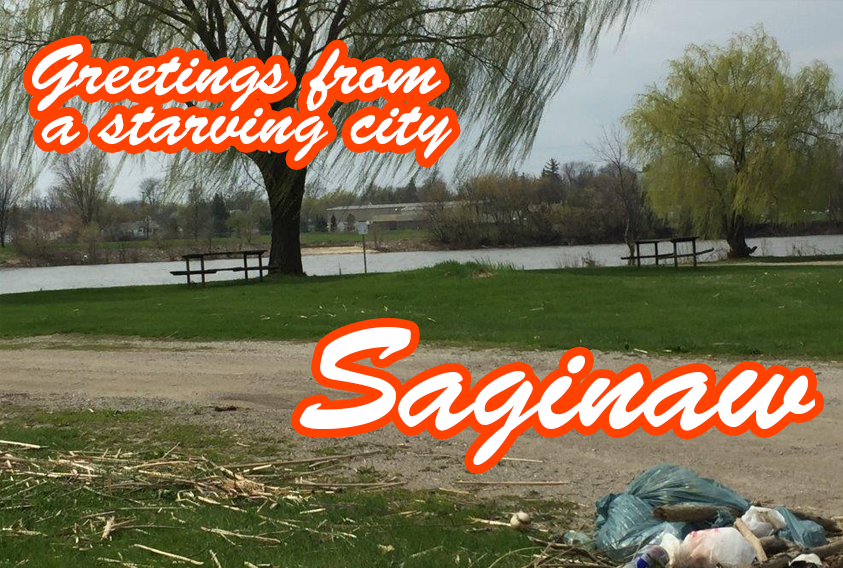In Saginaw, parks and wreck
SAGINAW – Wickes Park Drive used to be a vibrant place, with cookouts on a plush strip of grass along the Saginaw River. Today, the families and the soccer nets are gone, replaced with bags of trash and empty, dilapidated picnic tables.
The city of Saginaw has, to a large extent, abandoned its parks, scraping just enough out of its shrinking coffers to mow the grass.
State revenue sharing funds used to be the biggest chunk of the city’s budget. As that money has been cut by the state over the years, the parks and recreation department was eliminated and what was left was tucked into a department that is responsible for landscaping city property.
That’s because all the city can afford to do now is cut the grass at the parks, said Tim Morales, the city manager. “Almost any park where you see activity, it’s because a community group has taken the lead and restored that park,” he said.
City-sponsored recreation gradually disappeared in Saginaw when Michigan began scaling back revenue sharing payments to municipalities statewide. In 2002, Saginaw got $12.4 million from state revenue sharing when the city had nearly 60,000 residents. In 2015, with about 50,000 residents, the amount was down to $7.89 million. The total city budget is about $30 million.
The city had a $600,000 parks budget in 2000, but that withered to $25,000 by 2013.
When adjusted for inflation, the parks budget is less than one-thirtieth what it was in 2002.
The money that’s left mows the grass and provides pay for college-age young adults to watch over the only recreation activity the city still runs - a splash pad where colorful sprinklers spray water on children in the summer, Morales said.
The splash pad sits alongside a skate park in Celebration Park on the location of the city’s former waterpark, which is now closed. The splash pad and skate park were funded by the Michigan Department of Natural Resources.
“We still have our parks, but we don’t offer programs for kids anymore which is a pretty big impact on our quality of life,” Morales said.
When the city had a parks and recreation department, it employed a couple dozen employees to staff the community pools, the water park, ice skating and organized youth sports such as baseball and basketball for thousands of kids and families each year, especially in the summer.
Today, if not for grants, churches, community groups and volunteers, Saginaw would have no parks and recreation programs. Volunteer organizations have stepped into the financial breach at some city parks, assuming duties that are performed by city employees in most communities.
The philanthropic support has had at least one notable success.
For nearly a decade, the historic Hoyt Park in Saginaw was a 10-acre mess of weeds and woe next to the city zoo. Gone were the ice skaters and T-ballers. The city had all but abandoned the site that had bustled with activities year-round dating back to the 1890s.
Then, in 2008, volunteers raised money for a massive cleanup, leased the park from the city for $1 and lured back organized athletics. In the winter of 2013, they flooded part of the park and brought back ice skating.
“We would love for the city to take this back over,” said Larry Brethauer, president of the Friends of Hoyt Park, a nonprofit group that operates the park. “But the city’s got no money.”
Saginaw faces even more financial restraints than most Michigan cities. In 1979, Saginaw residents voted to limit the amount of money the city can get from property taxes to $3.8 million or 7.5 mills – whichever is less. So while most cities get the largest share of funding from property taxes, in Saginaw property tax revenue is the third highest revenue source behind income taxes and revenue sharing.
Cuts have hit other parts of the city budget, but it’s unlikely any department took as hard a hit as parks and recreation. The city has cut the legal department to save $200,000 a year, made cuts to police and fire positions and outsourced some accounting. Prior to revenue sharing cuts, the city employed about 1,000 people, but is now down to about 430, Morales said.
People who remember the days before the cuts to revenue sharing lament the difference they see in Saginaw now that parks and recreation programs are no longer a city function. An 81-year-old, lifelong Saginaw resident walked around the perimeter of Hoyt Park on a recent Monday. He recalled years past when the parks were destinations for cook outs, ice skating, basketball, baseball and swimming.
“We used to have a lot of stuff,” he said, shaking his head in disappointment and declining to give his name. “Back in the day.”
See what new members are saying about why they donated to Bridge Michigan:
- “In order for this information to be accurate and unbiased it must be underwritten by its readers, not by special interests.” - Larry S.
- “Not many other media sources report on the topics Bridge does.” - Susan B.
- “Your journalism is outstanding and rare these days.” - Mark S.
If you want to ensure the future of nonpartisan, nonprofit Michigan journalism, please become a member today. You, too, will be asked why you donated and maybe we'll feature your quote next time!


 The area along Wickes Park Dr. in Saginaw was once a bustling. Today, soccer nets are gone and the grassy shoreline is in poor condition because the city can’t afford the upkeep. (Bridge photo by Chastity Pratt Dawsey)
The area along Wickes Park Dr. in Saginaw was once a bustling. Today, soccer nets are gone and the grassy shoreline is in poor condition because the city can’t afford the upkeep. (Bridge photo by Chastity Pratt Dawsey)